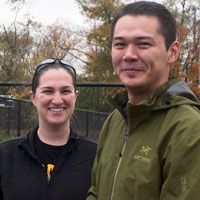
It was an unseasonably cold late-October afternoon, with Hurricane Sandy churning up the East Coast. Ominous skies threatened to unleash a downpour at any moment, but that didn’t keep the 13 members of the Challenger team off the baseball diamond at Barcroft Park in Arlington, Va.
The dedicated young athletes were members of the Challenger Division of the Arlington Little League, which enables boys and girls ages 4-22 with physical and mental challenges to enjoy the game of baseball. Matching their enthusiasm were students from the Physical Therapy (PT) program at the George Washington University School of Medicine and Health Sciences who volunteer as “buddies” for the Challenger players, providing encouragement and assistance throughout the game.
Cathy Makara, who organizes the Challenger team says that the PT students’ involvement is invaluable to the players. “It gives our kids freedom from their parents and allows them to show their independence,” she says, which is a crucial aspect of development for children with disabilities.
The partnership with Challenger Baseball is just one example of the countless ways that PT students are serving their community as a part of the doctoral program’s Thousand Hour Challenge. The goal is to perform at least 1,000 hours of community service by the start of the spring semester in January, which looks promising considering that they already reached 848 hours at the end of November.
“It’s something to get students excited and engaged with the D.C. community,” says Peter Tooley, who co-chairs the PT program’s community service efforts along with Caitlin Belfield, a fellow second-year student. Rachel Plumb and Laura Andrews, first-year PT students, have been selected as co-chairs for the next academic year.
The role of the community service co-chairs is not only to facilitate events, but also to encourage the 108 students in the PT program to find their own ways to get involved and give back to their community. “It provides tangible experience that helps us in the classroom, while also allowing us to serve an underserved population – which is great,” Tooley says.
Students have volunteered hundreds of hours at a variety of charity races, community health fairs, and non-profit organizations around the region. Some dedicate their time to the Little Workers of the Sacred Heart Pro Bono Clinic – a physical therapy clinic in northeast Washington, D.C. that was founded by students from the PT program in 2008. Others provide fall risk and general health screenings at the annual FRIENDS Neighborhood Block Party in Foggy Bottom. “Each week students are out there practicing the skills we’re learning in class, getting valuable hands-on experience,” Tooley says.
The Thousand Hour Challenge is only in its second year, but Tooley says its inspiration has always been a part of the Physical Therapy program. “Service is a core value of the physical therapy profession, so it’s well-integrated into our clinical practice as well as our personal lives,” he says. “The goal now is to continue the tradition and build upon it.”
“The faculty is extremely impressed by the passion that the students bring in their commitment to the community,” says Alison DeLeo, DPT, NREMT-B, assistant professor in Health Care Sciences. “Each year it grows more and more and it’s really amazing to watch them give back so freely when we keep them so busy. It also helps them develop as clinicians,” she says.
Back at Barcroft Park, Michael Mauer watches in awe as Stephen Kozma, a dedicated 22-year-old with Cerebral palsy takes the plate in his power wheelchair. Mauer, who organizes the Challenger Baseball partnership along with fellow second-year PT student Naomi Miller, has been cheering the Challengers on every Sunday afternoon this season. He’s learned plenty about how kids with certain cognitive and physical deficits present and how spasticity affects function. But more importantly, he’s learned the importance of engaging with his community.
“It’s great to see the positivity that the children have because it’s infectious and too often they don’t have enough opportunities to share that with people,” Mauer says. “To be there and see it is a special experience.”


